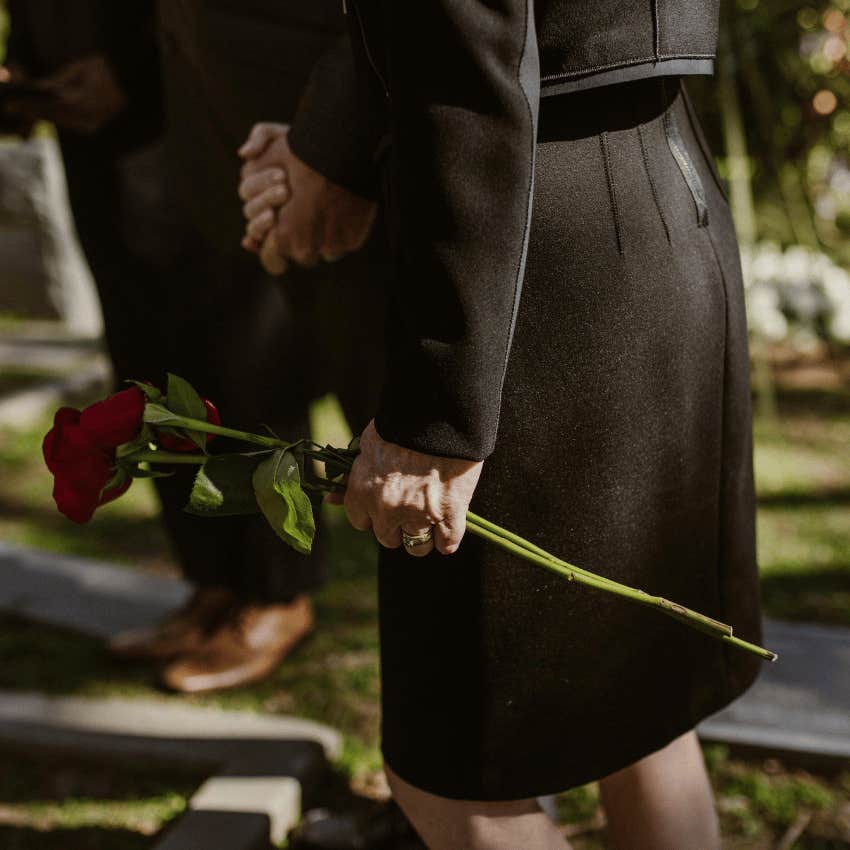The Black Dress That Taught Me An Odd Lesson About Love — 'Pay Attention To Minor Rips'
Revisiting lessons learned from a ripped hem.
 Oladimeji Odunsi | Unsplash
Oladimeji Odunsi | Unsplash Recently, I attended my father’s funeral and wore a black dress.
I felt uncomfortably hot in my black funeral dress and remembered the black dress from years ago that taught me about love.
It was a lesson and application that was difficult to practice with my father but one that I learned by trial and error and with a focus on myself (not expecting anything in return).
Over the past two weeks, I gave myself healing space to process my father’s passing and be a support to my siblings. Through it all and despite a traumatic childhood, when we gathered for our father’s final farewell, I had peace, acceptance, and love in my heart.
 RDNE Stock project | Pexels
RDNE Stock project | Pexels
I once had a favored black jersey dress that was perfect for work. It was my go-to dress.
It never needed ironing; wearing it was like being clothed in a newborn’s skin. It was a de-stressor, like wearing therapy. Wearing this dress made the world a less harsh place.
Eventually, I noticed that a portion of the hem was ripping. I ignored the tearing and wore it a few times, each time telling myself, “Remember to fix that hem.” I washed it and wore it again, forgetting that hem.
One day, upon arrival at work, just as the morning bell was about to ring for a packed day, I noticed the entire hem had ripped. I had no time to hem it, no thread or needle anyway, and no time to go to the store to buy the tools needed for the necessary repair work.
Quickly scouring my desk, I grabbed the stapler and stapled the entire hem. It worked so well that I left it stapled and wore it twice more before doing the traditional needle and thread job.
The dress is long gone now, but not the memory of how I felt in it.
That dress defines what love should be like. Love should be perfect for work and play. It should fit well and caress us gently amid busy and ragged lives.
Love should be our go-to, the bearer of our good, bad, and ugly, and should have the capacity to clothe us in softness and comfort no matter what. Love should be our de-stressor, our therapy for all that ails us — the thing that makes the world less harsh.
When love rips, as it sometimes does, with a misunderstanding, an overlooking, an argument, or anything, we should be able to wear love anyway. We should be able to give the giver of love the benefit of the doubt that the ripping was unintentional, just a matter of life’s wear and tear on them.
Love might need hemming sometimes, darning that holds it in place until we can complete all mending with diligence. But whether it’s stapling, darning, or complete sewing, mending takes work, and repairing hurts.
But, if we know how being dressed in our love feels, how secure and comfortable we are in it, we would endure the needling and threading that mending involves. We would welcome the mending process.
Sometimes, we get love all wrong. One or both parties are not naked enough under love’s dress for it to fit as it should. It still feels great, but we know something is missing. Our gut, spirit, or some little ripping or tearing says to pay attention.
 Marcelo Chagas | Pexels
Marcelo Chagas | Pexels
Had I paid attention to my minor ripping, I would have prevented a complete hemming catastrophe.
And I would not have reached emergency status to restore my dress. I also would have gotten my initial emergency stapling right.
Initially, when I stapled the hem, I did it outside-in so that the staple folds were underneath and against my skin. I soon realized that an inside-out technique was better as there were no potential jagged edges that could scratch me and no little bumps against my skin that could irritate me.
So it is with mending our relationships. When we must take darning, hemming, and repairing action, we must slow down, apply thought, and use care and precision in our efforts and words. Our efforts should not wound, scratch, or irritate. Our repair efforts should restore and make whole again.
As I ultimately needed a needle and thread to repair my dress, we required the right tools to examine and mend our lives and relationships. We need to examine ourselves first and own our breakings and loosenings.
The staples, needles, and thread we employ in the mending should prick and tug at us, not the other who also wears love’s dress. Additionally, we should aim for repair when we notice a small tear, not wait for an entire unraveling that creates an emergency.
Sometimes, we use substitute tools to give the illusion of having it all together. But the dream never lasts. A temporary fix is just that. It will hold the unraveling in, but eventually, we must properly assess the damage and permanently repair what has been broken, ruptured, or ripped.
We do that by stepping back, removing ourselves temporarily, carefully inspecting the damage, and determining the right tools and methods for the tailoring. We do that by using the staples, and preferably the needles, to fix ourselves, our thoughts, our hearts, our insecurities, and our inadequacies. Only then can we put on love’s dress and engage in accessorizing.
Michelle Ann Patrovani, Ed.D., is a writer, educator, former school leader, and mom to two phenomenal young men with Cystic Fibrosis (CF), whom she considers her greatest gifts and teachers in life. Her articles have been featured in the NYAPE Journal, Cystic Fibrosis Foundation Blog, LinkedIn, and various Medium publications, including Invisible Illness and Thirty Over Fifty.

